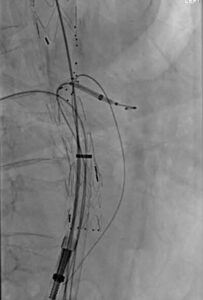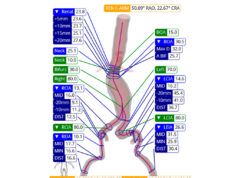This advertorial is sponsored by Terumo Aortic.

On 9 April 2024, a significant milestone was achieved as Terumo Aortic introduced the first implantation of the Fenestrated TREO device in Asia. The procedure was performed at Tan Tock Seng Hospital (TTSH) in Singapore by Glenn Tan, Lawrence Quek and Pua Uei.
TTSH is the flagship tertiary hospital of the National Healthcare Group and one of the largest multi-disciplinary hospitals serving central Singapore. The centre operates 2,000 beds and has been performing complex endovascular aortic aneurysm repair for over 10 years.
The next-generation Fenestrated TREO endograft has reliable staged expansion for a controlled deployment, with a trusted 19Fr, low-profile delivery system to treat short-neck and juxtarenal/pararenal abdominal aortic aneurysms. Fenestrated TREO offers the physician numerous key features, including the ability to reposition the graft while partially deployed; circumferential suture wraps; modified distal clasping to improve torque control; the ability to cannulate from above and below, enabling faster and safer access for dealing with narrow anatomies; and, notably, an optimal delivery time of less than five weeks.
These features benefit physicians by providing them with the opportunity to deliver the best treatment solution to meet the needs of their patients.


The patient receiving the first Fenestrated TREO device in Asia, presented with a challenging juxtarenal aortic aneurysm with a narrow visceral segment where the superior mesenteric artery and both renal arteries arise in close proximity to one another. The Fenestrated TREO device emerged as the optimal solution to accommodate the small iliac arteries and narrow visceral segment.

Tan, reflecting on the success of the procedure, commented: “One of the reasons we selected Fenestrated TREO was for its ability to accommodate the patient’s unique anatomy. The low-profile delivery system allowed atraumatic delivery of the endograft into the aorta and easy repositioning when partially deployed. The circumferential reduction ties further facilitated easy manipulation despite the narrow visceral segment of 16mm in this patient.”

“The reinforced fenestrations feature radiopaque tantalum coil nitinol rings and a circumferential radiopaque marker, allowing improved visualisation and alignment accuracy, facilitating quick cannulation. The locking stents in the iliac limb also reduces the risk of limb separation and endoleaks”, added Quek.

“The open top cap design of the endograft allows cannulation from above in challenging down-sloping visceral vessels, without the need for preloaded catheters, which keeps the endograft in a low profile 19Fr on-demand delivery system, which is highly advantageous in Asian patients who often have small iliac arteries.” commented Pua.













